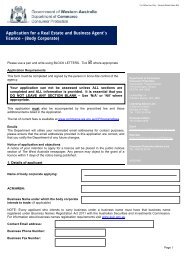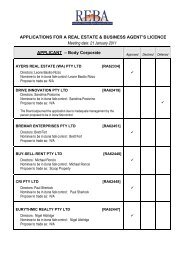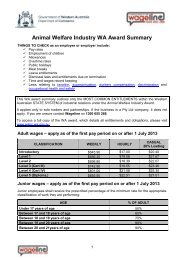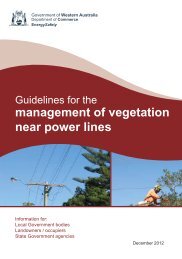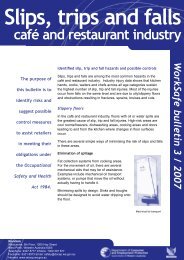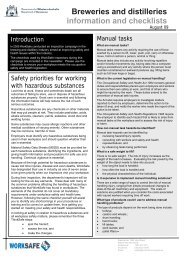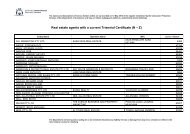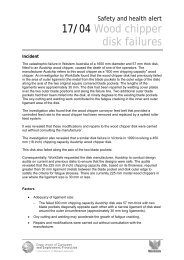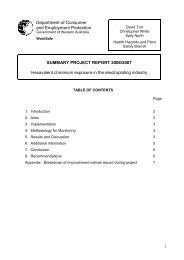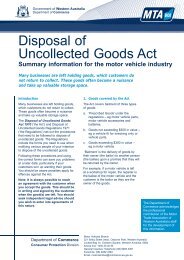Trust account handbook - Department of Commerce - wa.gov.au
Trust account handbook - Department of Commerce - wa.gov.au
Trust account handbook - Department of Commerce - wa.gov.au
Create successful ePaper yourself
Turn your PDF publications into a flip-book with our unique Google optimized e-Paper software.
2.8 Buffer <strong>account</strong><br />
Agents sometimes maintain a surplus amount within the trust <strong>account</strong> to absorb any inadvertent<br />
deficiencies that may arise from dishonoured bank cheques or bank charges.<br />
In no circumstances should extra funds be kept in the trust <strong>account</strong>.<br />
A buffer fund cannot be used to <strong>of</strong>fset bank fees or for any other reason. Agents should clear their<br />
commission or fees <strong>account</strong> to their general <strong>account</strong> at least weekly. Consumer Protection strongly<br />
recommends against the practice <strong>of</strong> retaining commissions and management fees in the trust<br />
<strong>account</strong> for an extended period <strong>of</strong> time.<br />
The removal <strong>of</strong> these excess funds from the trust <strong>account</strong> is for the benefit <strong>of</strong> all parties. If an agent<br />
maintains a buffer in a trust <strong>account</strong>, they will not be a<strong>wa</strong>re when the trust <strong>account</strong> is overdrawn.<br />
This means they are less likely to identify poor trust <strong>account</strong> management practices or fr<strong>au</strong>d by<br />
employees. The person in bona fide control is responsible for checking each ledger <strong>account</strong> each<br />
month to determine if specific ledgers are overdrawn and to correct any errors.<br />
2.9 <strong>Trust</strong> <strong>account</strong> transfer journal entries<br />
An agent may wish to transfer funds between client trust ledger <strong>account</strong>s within the trust ledger.<br />
In this situation, it is not necessary to withdraw the funds from the bank trust <strong>account</strong> and redeposit<br />
them. Rather, the transfer can be achieved through appropriate client trust ledger <strong>account</strong> entries<br />
and recorded in the trust <strong>account</strong> transfer journal.<br />
The role <strong>of</strong> the trust <strong>account</strong> transfer journal is to provide a clear <strong>au</strong>dit trail between taking money<br />
from one client ledger and crediting it to another client ledger. The use <strong>of</strong> a transfer journal is not<br />
compulsory unless transfers are made.<br />
When transferring funds between client ledgers it is important to remember that, in some cases,<br />
an <strong>au</strong>thority in writing will be required from the client concerned (ie the sale <strong>of</strong> one property and<br />
purchase <strong>of</strong> another).<br />
The trust <strong>account</strong> transfer journal must include the following information:<br />
17<br />
• the date <strong>of</strong> transfer;<br />
• the name <strong>of</strong> the trust ledger <strong>account</strong> from which the money is transferred;<br />
• the name <strong>of</strong> the trust ledger <strong>account</strong> to which the money is transferred;<br />
• a notation or code indicating the purpose for which the money is transferred; and<br />
• the amount <strong>of</strong> money transferred.<br />
Where more than one trust <strong>account</strong> is held by an agent, a separate transfer journal must be<br />
maintained for each trust <strong>account</strong>.<br />
Transfer journal entries equate to both a payment and a receipt <strong>of</strong> trust money and therefore<br />
must be fully recorded. Explanatory notes for each journal entry should be included. Receipt and<br />
payment transactions should be supported by signed trust documents (receipt forms and cheque<br />
butts). The agent should also sign transfer journal entries as evidence <strong>of</strong> the agent’s <strong>au</strong>thorisation<br />
<strong>of</strong> the entry. To reduce the incidence <strong>of</strong> error or theft, the person in bona fide control should sign <strong>of</strong>f<br />
all entries in the trust <strong>account</strong> transfer journal.<br />
SETTLEMENT AGENTS’ TRUST ACCOUNT HANDBOOK



